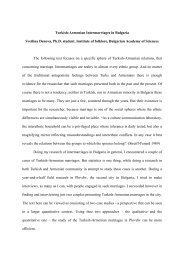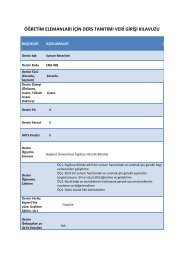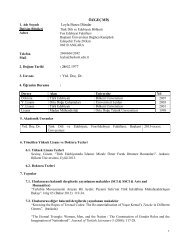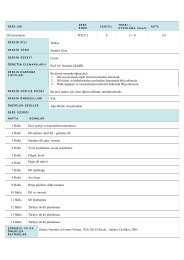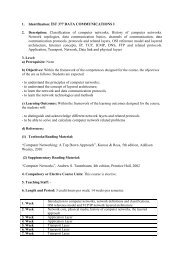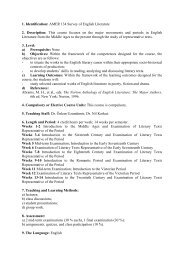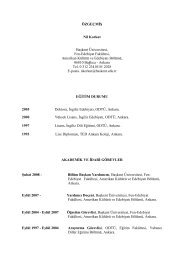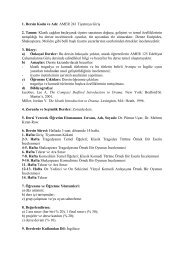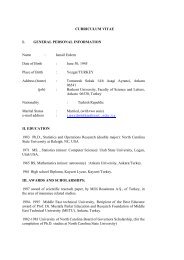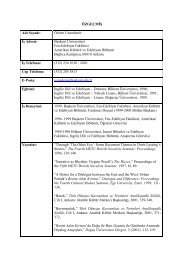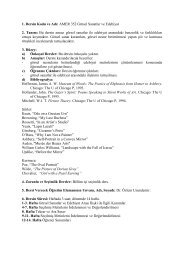You also want an ePaper? Increase the reach of your titles
YUMPU automatically turns print PDFs into web optimized ePapers that Google loves.
<strong>SEMA</strong> <strong>ASLAN</strong><br />
BAŞKENT UNIVERSITY, TURKEY<br />
“REFLECTIONS FROM THE TURKISH NARRATIVE TRADITION:<br />
FROM DEDE KORKUT TO LATIFE TEKIN”<br />
The novel Dear Shameless Death published in 1983 by Latife Tekin, narrates in a magical<br />
manner, the migration of a family from the village to the city and their life before and after<br />
immigration. In the novel, the life of the Aktaş family in the village and the painful realities they<br />
experience in the city are depicted in a fantastic manner which includes the motifs of folk<br />
literature as well. Dear Shameless Death carries traces from one of the most important work of<br />
Turkish folk literature, the Dede Korkut Stories. Dede Korkut Stories were collected from<br />
Eastern Anatolian and Azerbaijan folklore in the 16th century; however, the creation of these<br />
stories dates back to oral literature. This paper will compare Dear Shameless Death and Dede<br />
Korkut Stories from the point of view of motifs, language, and narrative techniques.<br />
Dear Shameless Death is a novel which uses the transition from the real to the fantasy<br />
frequently, without the intervention of the narrator to distinguish the real from fantasy. These<br />
transitions from one to another are given in such a smooth way that the reader does not sense a<br />
feeling of absurdity as they are reading the novel. Also, the reader does not question the reality<br />
of those elements of fantasy which are revealed through the viewpoint of the characters living in<br />
the village, because the villagers have a tendency to believe in such fantasies. Another reason that<br />
diminishes the feeling of absurdity against the fantastic events is that the Turkish reader is<br />
familiar with such events in oral tradition especially in some of the stories of Dede Korkut such<br />
as “Bamsı Beyrek,” “Deli Dumrul,” “Boğaç Han” and “Tepegöz.” Latife Tekin has not created<br />
the elements of fantasy in her work; she has re-presented these already existing elements in her<br />
own stylistic way. Her natural presentation of these elements is supported through incantations,<br />
charms, and fortune telling.<br />
One of the elements of fantasy is the relationship between the Angel of death, Israel and<br />
Atiye in Dear Shameless Death. Atiye is a woman who is always anxious about her husband and<br />
children, she carries the whole weight of the family because of her husband’s ignorance and
therefore, she is always in grief. Thus, she becomes ill frequently and meets the Angel of death<br />
four times. When Israel comes, he sits on her chest, examines her heart and informs her that her<br />
time of death has come. Every time, Atiye manages to extend her life span by bargaining or<br />
fighting with Israel. This motif is similar to the one in “Deli Dumrul.” Israel sits on Deli<br />
Dumrul’s white chest just as he sat on Atiye’s and Deli Dumrul also starts to bargain with Israel<br />
to save his life. Israel accepts Deli Dumrul’s offer only on condition that Deli Dumrul finds<br />
someone else who would give his life to Israel instead.<br />
In Dear Shameless Death, some of the elements of fantasy are derived out of the genie<br />
and fairy motifs. These motifs are predominantly used in those parts of the novel where the<br />
setting is the village. A genie strikes Bayraktar, one of the villagers, for he pees on them; his face<br />
and mouth becomes crooked. Later on, he marries a fairy. A villager called Genie Mehmet is<br />
choked to death by the genies three days after Atiye gives birth to Dirmit. A fairy called Yellow<br />
Girl becomes a pest to Akçalı village and her aim is to control all the men in the village. The<br />
narration of these events not by the characters but by the narrator challenges the reader to<br />
question, whether the fantastic and supernatural events in the novel reflect the imagination of the<br />
villagers, their approach to the events that they are incapable of explaining or the imagination of<br />
the narrator.<br />
In Dede Korkut, the fairy motif can be seen in “The Story of Basat’s Murder of Tepegöz.”<br />
From the relationship of Konur Koca with a fairy, a child called Tepegöz, with one eye in his<br />
forehead is born. Tepegöz brings disaster to the Oğuz tribe. The ring that his fairy mother gave<br />
him keeps him immune from arrow and sword wounds.<br />
Hızır, who is a religious figure in Turkish folklore, is also a motif frequently used in both<br />
texts. Hızır comes to save both Atiye in Dear Shameless Death and Boğaç Han in Dede Korkut<br />
Stories when they are in trouble. Mourning for the loss of the beloved ones is another motif used<br />
in both texts. In Dear Shameless Death, a woman, whose husband has died under subsidence, is<br />
described as below:
Blind Fadime pulled off her scarf. She knelt down beside the fissure of Taçın.<br />
She lamented after her dead husband as she waved her scarf. The women<br />
plucked their hairs out. They stuck their nails in their face and bled. (19)<br />
the same way:<br />
Now we will see how the motif of mourning is depicted in Dede Korkut Stories in almost<br />
His (Bamsı Beyrek’s) white haired mother drowned into tears, she stuck her<br />
nails to her white face, she ripped her red cheeks, she plucked out her hair,<br />
and she came home in tears and moans. (“BB”, 70)<br />
Another motif that can be seen in both texts is the motif of talking to other beings like the<br />
wind, the mountains, plants, etc. When Dirmit is in the village she speaks to the water well, the<br />
wind and the rose. When the family migrates to the city, she speaks with the kuşkuotu, which is<br />
a plant that grows in the corners of parks. Her speech is in the form of a dialogue rather than a<br />
monologue.<br />
The reason why Dirmit speaks to other beings is the result of the oppression her family<br />
applies on her. Atiye, Dirmit’s mother, sees a fault in everything and punishes her. For instance,<br />
as Berna Moran emphasizes, “Atiye believes that Dirmit’s passions, the things she gives<br />
importance are the doings of genies and therefore, all the novels she reads, the poems she writes<br />
are ripped apart and Dirmit’s wish to make a sculpture is prevented by Atiye.” (Moran 82) Thus,<br />
Dirmit takes refuge in other beings. She gives her secrets to the wind, flowers and the water well<br />
without the fear of being criticized by her mother.<br />
Similarly, in Dede Korkut Stories, the feeling of helplessness pushes the characters to<br />
seek understanding from other beings. When Salur Kazan sees his house plundered after he<br />
returns from hunting, first he speaks to his land, then to water and a dog. Uruz, before being<br />
executed by his enemies, wants to speak to a tree. Dirse Han’s wife yells out to the Kazılık<br />
Mountain when she sees her son lying on the ground in blood injured. The only difference we<br />
can see in both texts that, in the application of this motif is that in Dear Shameless Death, talking<br />
to other beings can be in the form of a conversation. Whereas in Dede Korkut Stories, the other<br />
beings do not reply back to the characters and these speeches are usually in the form of<br />
monologues.
The numbers three, seven and forty have a very significant place in Turkish folk narrative<br />
tradition. In folkloric narration, there is no specificity in time and place. Rather, events occur<br />
within a three-term period, which can be three hours, days, weeks or years. Also, multiplicity is<br />
depicted through the numbers three, seven or forty. In both texts this motif of numerics is<br />
frequently used. In Dede Korkut Stories, forty women accompany the wife of the Hun, and forty<br />
brave men accompany the Hun. All the celebrations last for forty days and forty nights. When<br />
Basat prays for freedom, seven doors open to lead him out. In Dear Shameless Death, Dirmit<br />
believes that the genies live under seven levels of the earth, and to get rid of Halil’s bad luck, his<br />
family scatter three handfull of soil under his pillow. They believe that Nuğber’s fortune will<br />
turn for the good in a three-term period and she will meet a proper husband within this period.<br />
The last motif I will talk about is the motif of dreams. In both texts, the most important<br />
function of dreams is to explain the events in the past or to foreshadow those that will happen in<br />
the future. In Dear Shameless Death, in a dream Atiye sees herself in front of a metal cradle<br />
when she is shut in the stable. She kneels down to kiss the baby’s head which she will bear in<br />
nine months. She also sees her son Seyit being shot in her dream:<br />
Atiye leaped up suddenly from her dream. She controlled Seyit’s bed in fear.<br />
She stood straight resembling an insane person. She said ‘They shot Seyit.’ (12)<br />
The same description can be seen in the story where Salur Kazan’s house is plundered in<br />
Dede Korkut:<br />
At night the shepherd saw an annoying dream. He leaped up suddenly from his<br />
dream. He woke his brothers up and they closed the door tightly. (“SK”, 40)<br />
At this point the plunderers have attacked his master’s house.<br />
Language and Narration:<br />
Latife Tekin makes use of Turkish colloquial language extensively in Dear Shameless Death.<br />
This language is saturated with the elements belonging to folk culture and superstitions of<br />
villagers, and it makes this novel closely connected with the Turkish oral literary tradition.
Some important aspects of the language of Dear Shameless Death bring to mind Turkish folk<br />
narration and the Dede Korkut Stories. Now, I will give you a general panorama of the discourse<br />
used in both Dede Korkut Stories and Dear Shameless Death.<br />
Colloquial Words, Expressions and Phrases:<br />
Dear Shameless Death involves folkloric words and phrases, which shows as Murat Belge<br />
states in his book titled Writings About Literature, that “Latife Tekin is able to represent the<br />
village life from within” (Belge 233-243). I believe that her success is derived from her careful<br />
and extensive usage of folkloric language without imitating the regional dialectics.<br />
As the Aktaş family migrates to the city, the language of the novel starts to acquire more of<br />
the terms that the city life brings forth, such as engineer, cancer, radiator, firm, hair curler. For<br />
this reason, in the second part of the novel, the usage of folkloric words decreases.<br />
As a comparison, I would like to mention that the Dede Korkut Stories were composed<br />
approximately in the 15 th century. They also include many folkloric words and phrases, some of<br />
which are still being used today. Both texts include folkloric expressions that reflect the<br />
background and the perspective of the characters towards life. Both texts include similes that<br />
help the reader to find clues to the characters’ environment and life. To give a few examples<br />
from Dear Shameless Death: Atiye’s cry is compared to the bawl of a calf, Dirmit’s long hair that<br />
falls to her shoulders is compared to the tail of a rat, and her hanging around her mother is<br />
compared to the appearance of a lousy dog with an injured leg. The life in the village is<br />
described in these examples with the help of similes. In Dede Korkut Stories, we can find similar<br />
clues about the life of the nomadic tribes and their environment. In the nomadic tribes people<br />
were usually in a struggle with nature, they had to act fast and dynamically. Those who led this<br />
kind of a life had to be strong, since only the strong survived and therefore, these people<br />
resembled powerful beings. For example, in “The Story in which Salur Kazan’s House was<br />
Plundered,” Kazan Han is described as follows:<br />
One day Kazan, the son of Ulaş and the son of the predatory bird, the hope of<br />
the homeless poor, the lion of the Amıt river, the tiger of the Karacuk, the
owner of the dark red horse, the father of Uruz Han, Bayındır Han’s son-in-law,<br />
the happiness of the powerful Oğuz Tribe, stood up. (“SK”, 30)<br />
In Dear Shameless Death, characters express their emotions directly, they either curse or<br />
swear when they are mad. Cursing is usually the choice of the female characters, while the males<br />
chose to swear. Latife Tekin explains why these characters do not feel the need to hide their<br />
emotions. She says:<br />
The characters in the novel have more freedom than we do, they are able to<br />
express the things that we are not able to say freely. This feeling of freedom<br />
seems to be one of the reasons why I write.<br />
(www.garaldi.sabah.com.tr)<br />
In Dede Korkut Stories also, the characters curse or use insults when they are mad.<br />
However, the extensive usage of curse or insult is predominantly given through the dialogues of<br />
the servants rather than the noble Hans or Hatuns.<br />
Poetics:<br />
Another common aspect in both texts can be seen in their poetic language. Dede Korkut<br />
Stories carry traces from both the epic genre and the Turkish folk stories. One of the epic<br />
qualities in Dede Korkut Stories is its poetic narration. The elements that make the language of<br />
Dede Korkut Stories poetic are the repetitions of words, phrases and sentences. Some words are<br />
repeated in the same sentence one after another and, others in the following sentences. Also, the<br />
same suffixes are repeated at the end of the following sentences, in order to create a rhythmic<br />
reading of the text.<br />
Similarly, the words at the end of each sentence in Dear Shameless Death are written by<br />
using the same suffix except in the dialogues of the characters. Also, the sentences are short and<br />
the usage of the same suffixes, one after another at the end of these short sentences, give the text<br />
a musical quality. In some of the sentences in the novel, “seci,” meaning rhyme in prose, is used<br />
to emphasise the rhythmic quality of the novels.<br />
As a conclusion, the language material Latife Tekin uses in Dear Shameless Death is the<br />
language of folklore that have been carried up to now since the composition of Dede Korkut<br />
Stories. The elements of fantasy used in Tekin’s work are not her own creation but carry cultural
implications that reflect the collective subconscious of the Turkish reader. Thus, I believe that,<br />
the Turkish reader has contributed to the writing of this novel.<br />
Dear Shameless Death has been mentioned in many articles since the first day it was<br />
published. These articles emphasize the quality of originality and the novel’s place as a<br />
prototype among Turkish novels. I believe that Dear Shameless Death has reached this<br />
originality through its usage of folk language and its ability to depict the existing beliefs in<br />
Turkish culture. This can be explained by Carl Gustav Jung’s collective subconscious theory.<br />
Jung believes that every era has its own special tendencies, prejudices and psychological<br />
processes. An era resembles a human. Similar to a human, who buries the tendencies, troubles<br />
and psychological processes in his/her subconscious, the society also uses its collective<br />
subconscious to remain in balance. Jung states that: “If an artist manages to reflect the longings<br />
that the society has buried in its collective subconscious in his/her works, then s/he could be<br />
successful” (Jung 70). I believe Latife Tekin is successful because she manages to reflect the<br />
elements that are buried in the collective subconscious of the Turkish people. In conclusion the<br />
similarities in terms of motif, language and narration between Dede Korkut Stories composed in<br />
the 15 th century and those in Dear Shameless Death written in 1983, disclose the collective<br />
subconscious of the Turkish reader.<br />
Works Cited<br />
Altuğ, Fatih. “Sevgili Arsız Ölüm: Madun Konuşabilir mi?”<br />
http://mizan.bnet.net. tr/ezine/article. asp?23<br />
Belge, Murat; Edebiyat Üzerine Yazılar. İstanbul: İletişim Yayınları, 1998. 233-243.<br />
Ercilasun, A. Bican. Dede Korkut Mirası. http://www. tdk. gov. tr/dedekorkut2html<br />
Ergin, Muharrem. Dede Korkut Kitabı 1-2. Ankara: TDK Yayınları. 1997.<br />
---. Dede Korkut Kitabı. İstanbul: Boğaziçi Yayınları, 1996.<br />
Jung, Freud, ve Adler: Psikanaliz Açısından Edebiyat. Ankara: Dost Yayıncılık, 1983.<br />
Moran, Berna. Türk Edebiyatına Eleştirel Bir Bakış 3. İstanbul: İletişim Yayıları, 2001.<br />
Moran, Berna. Edebiyat Kuramları ve Eleştiri, İstanbul: İletişim Yayınları, 2001.<br />
Özbay, Hüseyin. Çolpan’ın Şiirleri. Ankara: TKAE, 1993. 173-273.<br />
Paker, Saliha and Mel Kenne. (From) Dear Shameless Death.
http://www. turkish-lit. boun. edu. tr/work. asp?CharSet=English&ID=1572<br />
Sezer, Sennur. “Sevgili Arsız Ölüm’den Aşk İşaretleri’ne Latife Tekin’in Anlatısının Dil ve<br />
Çerçevesi.” Varlık. 1995: 47-50.<br />
http://www. sabah. garaldi. com



